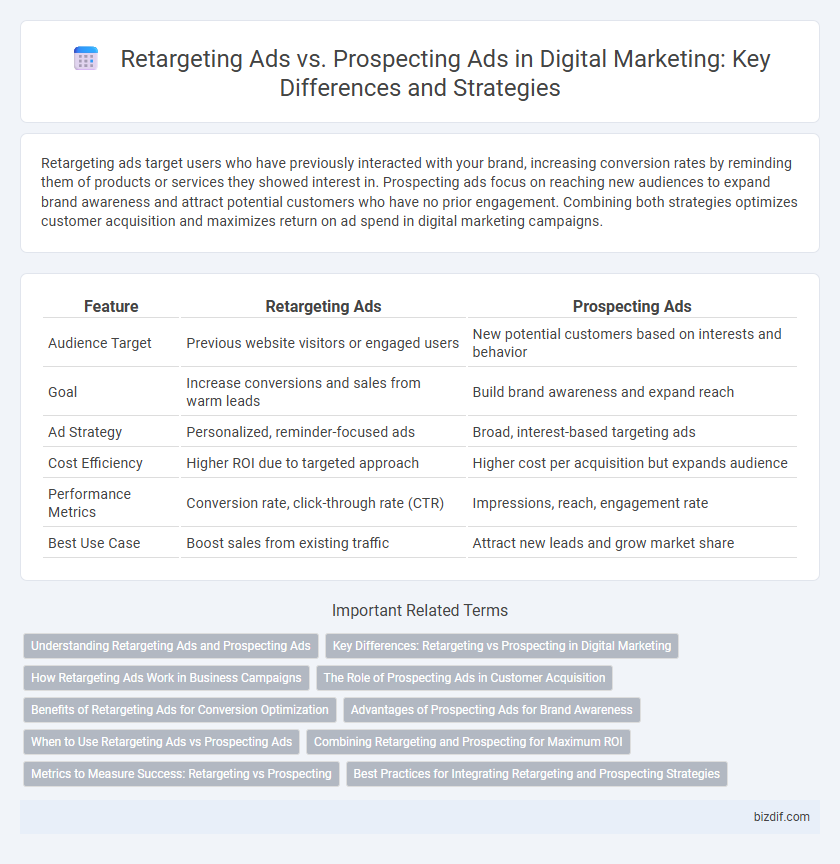Retargeting ads target users who have previously interacted with your brand, increasing conversion rates by reminding them of products or services they showed interest in. Prospecting ads focus on reaching new audiences to expand brand awareness and attract potential customers who have no prior engagement. Combining both strategies optimizes customer acquisition and maximizes return on ad spend in digital marketing campaigns.
Table of Comparison
| Feature | Retargeting Ads | Prospecting Ads |
|---|---|---|
| Audience Target | Previous website visitors or engaged users | New potential customers based on interests and behavior |
| Goal | Increase conversions and sales from warm leads | Build brand awareness and expand reach |
| Ad Strategy | Personalized, reminder-focused ads | Broad, interest-based targeting ads |
| Cost Efficiency | Higher ROI due to targeted approach | Higher cost per acquisition but expands audience |
| Performance Metrics | Conversion rate, click-through rate (CTR) | Impressions, reach, engagement rate |
| Best Use Case | Boost sales from existing traffic | Attract new leads and grow market share |
Understanding Retargeting Ads and Prospecting Ads
Retargeting ads target users who have previously interacted with your website or app, increasing conversion rates by reminding interested prospects to complete a purchase. Prospecting ads focus on reaching new audiences based on demographics, interests, and behaviors to expand brand awareness and attract potential customers. Both ad types serve unique roles in the digital marketing funnel, with retargeting driving engagement from warm leads and prospecting generating fresh leads.
Key Differences: Retargeting vs Prospecting in Digital Marketing
Retargeting ads focus on re-engaging users who have previously interacted with a brand, using personalized and behavior-driven messaging to increase conversion rates. Prospecting ads aim to reach new audiences by targeting broader demographics and interests to expand the customer base and build brand awareness. Key differences include the audience stage in the sales funnel, with retargeting targeting warm leads and prospecting targeting cold leads, as well as campaign objectives and budget allocation strategies.
How Retargeting Ads Work in Business Campaigns
Retargeting ads work by tracking website visitors through cookies and displaying tailored ads to re-engage users who have shown interest but not converted, significantly increasing conversion rates. These ads leverage user behavior data to create personalized messaging, reinforcing brand recall and encouraging completion of desired actions such as purchases or sign-ups. Compared to prospecting ads that target new audiences, retargeting ads focus on warm leads, optimizing marketing budgets and improving overall campaign ROI.
The Role of Prospecting Ads in Customer Acquisition
Prospecting ads play a critical role in customer acquisition by targeting new audiences who have not previously interacted with a brand, expanding the potential customer base. These ads leverage data-driven insights and lookalike audiences to attract high-intent prospects through personalized messaging and compelling offers. By driving initial awareness and interest, prospecting ads create the foundation for subsequent retargeting efforts that nurture leads towards conversion.
Benefits of Retargeting Ads for Conversion Optimization
Retargeting ads significantly boost conversion rates by targeting users who have already shown interest in a product or service, increasing the likelihood of completing a purchase. These ads enhance brand recall and provide personalized messaging based on prior user behavior, resulting in higher engagement and lower cost per acquisition. By focusing on warm audiences, retargeting maximizes ad spend efficiency and drives more qualified traffic to conversion funnels.
Advantages of Prospecting Ads for Brand Awareness
Prospecting ads expand brand awareness by targeting new audiences who have not previously interacted with the brand, increasing market reach effectively. These ads leverage data-driven insights and algorithms to identify potential customers based on interests, behaviors, and demographics, optimizing ad spend for maximum exposure. By introducing products or services to untapped segments, prospecting ads foster brand recognition and drive long-term customer acquisition.
When to Use Retargeting Ads vs Prospecting Ads
Retargeting ads are most effective when targeting users who have already interacted with your brand, such as website visitors or previous customers, to increase conversion rates by reminding and encouraging them to complete a purchase. Prospecting ads work best when reaching new audiences, using data-driven targeting like lookalike audiences or interest-based segments to expand brand awareness and generate new leads. Utilizing retargeting during the consideration and decision stages complements prospecting efforts aimed at the awareness stage, optimizing the overall digital marketing funnel.
Combining Retargeting and Prospecting for Maximum ROI
Combining retargeting ads, which re-engage users who have previously interacted with your brand, with prospecting ads that target new potential customers, creates a powerful digital marketing strategy to maximize ROI. Leveraging data-driven audience segmentation allows marketers to deliver personalized messaging at different funnel stages, increasing conversion rates and reducing cost-per-acquisition (CPA). Integrating both tactics enhances brand visibility while efficiently nurturing leads, ultimately boosting overall campaign performance and revenue growth.
Metrics to Measure Success: Retargeting vs Prospecting
Retargeting ads typically yield higher click-through rates (CTR) and conversion rates due to targeting users already familiar with the brand, making cost per acquisition (CPA) a critical success metric. Prospecting ads focus on expanding the audience, so metrics like reach, impressions, and cost per mille (CPM) are essential to evaluate effectiveness. Monitoring return on ad spend (ROAS) across both strategies provides insight into overall campaign profitability and guides budget allocation.
Best Practices for Integrating Retargeting and Prospecting Strategies
Combining retargeting ads with prospecting campaigns enhances overall digital marketing performance by targeting users at different stages of the customer journey. Use data segmentation to create personalized retargeting ads for website visitors who did not convert, while deploying prospecting ads to attract new audiences based on lookalike and interest-based targeting. Monitor key metrics such as click-through rates, conversion rates, and customer acquisition cost to optimize budget allocation between retargeting and prospecting efforts for maximum ROI.
Retargeting Ads vs Prospecting Ads Infographic

 bizdif.com
bizdif.com